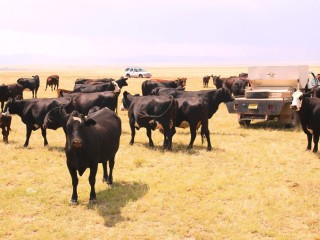 The Northern hemisphere summer drought and heat wave are rapidly becoming the story of the year for the US beef industry, leading North American analyst Steve Kay wrote on Friday in his authoritative US Cattle Buyers Weekly commentary.
The Northern hemisphere summer drought and heat wave are rapidly becoming the story of the year for the US beef industry, leading North American analyst Steve Kay wrote on Friday in his authoritative US Cattle Buyers Weekly commentary.
Half the US beef cow herd was now within areas of extreme drought, which is forcing herd liquidation and cattle movement into feedlots and to grazing regions in states with more grass, Mr Kay said in CBW.
“Searing heat from the Great Lakes to Texas is also hurting cattle feeding performance, and is putting a dent in retail beef sales,” he wrote.
“But the biggest impact might be on this year’s corn crop. A combination of heat and dryness during the critical pollination phase might force a sharp decline in yields for a significant part of the crop,” Mr Kay quoted US analysts as saying.
USDA currently forecasts a national corn yield of 158.7 bushels per acre, and will update its assessment in coming days. But private US forecaster Commodity Weather Group last week pegged national yields at only 150 bpa.
“Combined with an estimate of harvested acreage much lower than other estimates, this yield forecast would mean a crop of only 12.62 billion bushels. Other estimates, including that of USDA, are for a 13.2 billion bushel crop or higher,” Mr Kay wrote on Friday.
Anything less than 13 billion bushels would raise corn prices and make it even more expensive to feed livestock and poultry, analysts told CBW.
US cattle feeders, pork and chicken producers are already dealing with cash corn prices twice as high as this time last year in many places. Corn, basis Omaha, the week before last averaged US$7.10/bushel – almost exactly 100 percent higher than the same week last year.
“Add-in record high feeder cattle prices and cash-to-cash cattle feeding closeouts are currently negative by nearly $170 per head,” Mr Kay wrote. That calculation bears a striking resemblance to recent breakeven calculations carried out by Beef Central for the Australian feedlot industry, but for dramatically different reasons. US feedlot breakevens from now until the end of the year are calculated to be US$125-130 per hundredweight.
US consumer spending remains anaemic
Higher feed costs mean US cattle feeders will need to see much higher live cattle prices heading into 2012, say analysts. But such an increase might be restricted by a still spluttering US economy and its impact on beef sales.
The last-minute resolution last week of the federal debt crisis was expected to give US stock prices a lift, but new weak economic indicators and growing economic fears hit both the US and global stock markets last week. A negative factor was that US consumer spending, which accounts for 70pc of all economic activity, fell 0.2pc in June after only a 0.1pc increase in May. Personal income increased only 0.1pc while wages and salaries fell slightly.
US consumers increased their savings in June and slowed their spending on everything from restaurants to tax preparation services, according to the Wall Street Journal.
Consumers likely cut back on their overall spending on beef in June, as the US All Beef retail price in June was 9.4pc higher than a year earlier, analysts said.
Also commenting in the impacts of US drought in Chicago Mercantile Exchange’s Daily Livestock Report on Thursday, analyst Len Steiner said the ‘really serious’ seasonal conditions were in regions that normally ran the nation’s largest number of beef cattle.
“The Southern Plains, including Texas and Oklahoma has an astonishing 89.5pc of grazing lands rated in the two worst land condition categories – poor and very poor,” Mr Steiner said.
“It means that in these two states, that held 23pc of all the nation’s beef cows in January, only 9pc of land is rated in fair condition and 1.5pc is rated good. No acres in either state were rated excellent,” he said.
The extension of this situation now meant that many southern US ranches were running out of water.
“Water tanks and ponds are going dry and even groundwater sources are drying up in many areas,” Mr Steiner said. “There are things a cattleman can do when the grass is short, but hauling water is impractical for most cow herds.”
Across all US states, more than ten times the area of land was rated poor or very poor last week, compared with the same time last year.
